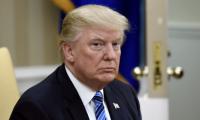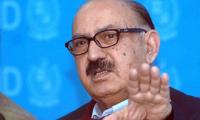Islamabad diary
Our mandated leaders, embattled and besieged, could have done without this latest addition to their troubles: the impending arrival of Pakistan’s stormiest and most mercurial cleric, the Reverend Dr Tahir-ul-Qadri. He is not just master of talk, which he undoubtedly is. He also has an army of disciplined and motivated cadres at his beck and call which gives him that advantage other political forces, for all their verbal flourishes, lack: street power.
Few parties can claim the distinction of putting the battalions of the Punjab Police to ignominious flight. Dr Qadri’s cadres not only stood up to brutal police firing during the Model Town incident – 14 dead, including two women, and scores injured as a result of direct shots to the body. Subsequently they stood up to the worst that the police could do both in Rawalpindi and Islamabad.
The Punjab Police have a well-earned reputation for being merciless with the weak and full of discretion when it comes to the strong. The path to the dharnas in August 2014 was opened not by Imran Khan’s PTI – let us be clear on this score – but the intrepidity of Dr Qadri’s Pakistan Awami Tehrik. And much as friend Aitzaz Ahsan, Senate opposition leader, likes to take credit for saving Nawaz Sharif’s government on that occasion, true help for the government came from Gen Raheel Sharif – who after seeing to it that the ruling PML-N had learned some lessons wisely decided not to intervene.
Power, or what remained of it after the dharna, lay spread out on a stretcher on Constitution Avenue. The Generalissimo had to give no command. He had merely to lift his eyelids and it would have been over for the government. Aitzaz Ahsan and Khurshid Shah played cameo roles. The higher direction came from other quarters.
Imran Khan and the Reverend’s folly was to prolong their dharnas after it had become clear that Gen Raheel was in no mood to oblige them. They should have packed their bags then and gone home. By lengthening the already dying chorus they lost dramatic effect. In life as in literature it doesn’t pay to prolong the closing scenes of a play.
But that’s the past and we are in the present. The Sharifs can handle talk and innuendo and allegations. They have been doing it for the last 30 years. ToRs and committees and judicial commissions don’t hurt them. There was a judicial commission set up after the Model Town killings. Its report has not been made public even after two years. So much for accountability and transparency, and the lofty principle invoked so much in these parts, the rule of law.
ToRs for the Panama leaks can be discussed for the next 20 months and nothing will come of them. Aitzaz Ahsan can be at his legal best and Syed Khurshid Shah can give up the ambiguities of which he is a past master and still nothing will come of this exercise, for without the threat of street power the discussions will remain so much hot air, impressive on paper and meaningless in substance.
Imran Khan is threatening agitation but his is an undisciplined and disorganised rabble. They can’t keep order at their rallies nor ensure security for women participants, and there is constant infighting amongst the top leaders. Mobilising street power and managing it requires discipline and a capacity for organisation, two of the PTI’s weakest points.
Indeed, organisation is not a strong point of any of Pakistan’s mainstream parties (except the MQM, although its drill-machine culture is something we could all do without). The PML-N for all its bluster now could never get more than 50-60 people on the Mall in Lahore during Gen Pervez Musharraf’s time. The PPP was similarly hamstrung in Gen Zia’s time – the 1983 MRD movement in Sindh largely a feudal-driven endeavour, the late Ghulam Mustafa Jatoi for one playing a leading role in it…not that you’ll get many PPP enthusiasts admitting to this.
The Pakistan Awami Tehrik is different. Through years of schooling and indoctrination, its cadres – drawn largely from the deprived sections of society and the lower middle class – form a motivated army with a honed capacity for hardship and struggle. Ask fellows like me to spend a night on a footpath and then see our reaction. For PAT workers, men and women, it’s part of a day’s work to carry the bare essentials of living with them and head for a rally near or afar. (Jamaat workers have similar dedication, as have activists of Hafiz Saeed’s Jamaat-ud-Dawaah.)
I have no sympathy, none whatsoever, for PAT’s religious and political doctrines. Too much religious lecturing doesn’t suit my sensitive temperament. And I don’t like the worthy Doctor’s flip-flops, his arrivals from Canada and his sudden departures. But having watched up close PAT’s Islamabad sit-ins, I am an unabashed admirer of the dedication and fortitude of its workers, men and women, especially the party’s women workers whose commitment to their cause, whether you agree with the tenets of that cause or not, is extraordinary.
Imran Khan was able to elicit the same kind of motivation from Pakistan’s hitherto apolitical and socially-dead mummy-daddy and burger classes. Men and women, including the young, who had never attended a political rally in their lives came to his rallies. But the PTI could never shape itself into an organised party and there was no curing the lack-lustre image of its second-tier leaders – the specialists of squabbling and party-infighting.
Minus PAT the Sharifs thus could ignore the threat of street agitation. But if the Reverend Doctor has come to stay for some time and settle scores over the Model Town killings that could spell trouble for the Sharifs. Nothing is going to come out of the extended discussions over the ToRs regarding the Panama leaks. The Sharifs have never been into political suicide before and they are not about to put their necks on the block now. But impasse will inevitably trigger talk of agitation.
The PAT sit-in at Charing Cross on June 17, the second anniversary of the Model Town killings, will draw the spectre of street agitation that much closer.
My impression, for what it’s worth, is that the Sharifs are not realising the danger. They think that they can bluster their way out of this mess although the clock is ticking and time is running out.
This time it looks as if the arena of contention is likely to be Lahore, not Islamabad. The Punjab Police, which is all the physical force at the government’s disposal, was unable to prevent the assault on Islamabad at the time of the dharnas. Will its performance be any better if things get hot in Lahore? Will the newly-raised Dolphin Force stop any move towards Raiwind?
People have mixed feelings about the Reverend Doctor. His followers think he is a messiah; his detractors, of whom there is no shortage, consider him no better than a charlatan. But he commands the loyal devotion of his followers. Imran Khan, as already noted, has mummy-daddy and burger support – and support lower down too, for let us not be uncharitable – but he has no organisation. So the key, I suspect, lies with the Reverend Doctor. What may be playing in his less-than-straight mind?
All these straws in the wind suggest we are headed for troubled times. The clouds of disorder are gathering. But I doubt if the PML-N leadership is reading the danger signs clearly.
Email: bhagwal63@gmail.com
People stand in line up as election officials check their ballot papers during voting general election at a polling...
Women show their voter identity cards as they stand in a queue before casting their votes in Agartala. — PTIThe 18th...
Former prime minister Imran Khan. — Instagram/ imrankhan.ptiAn old saying has it that “when you dance with the...
Kashmiris in Indian illegally occupied Kashmir protesting against the Indian occupation as the forces of India looked...
A representational image showing residents walking at a wholesale market in Karachi. — AFP/FileOnce again there is...
A representational image showing late Pakistani human rights activist and Supreme Court lawyer Asma Jahangir. —...







